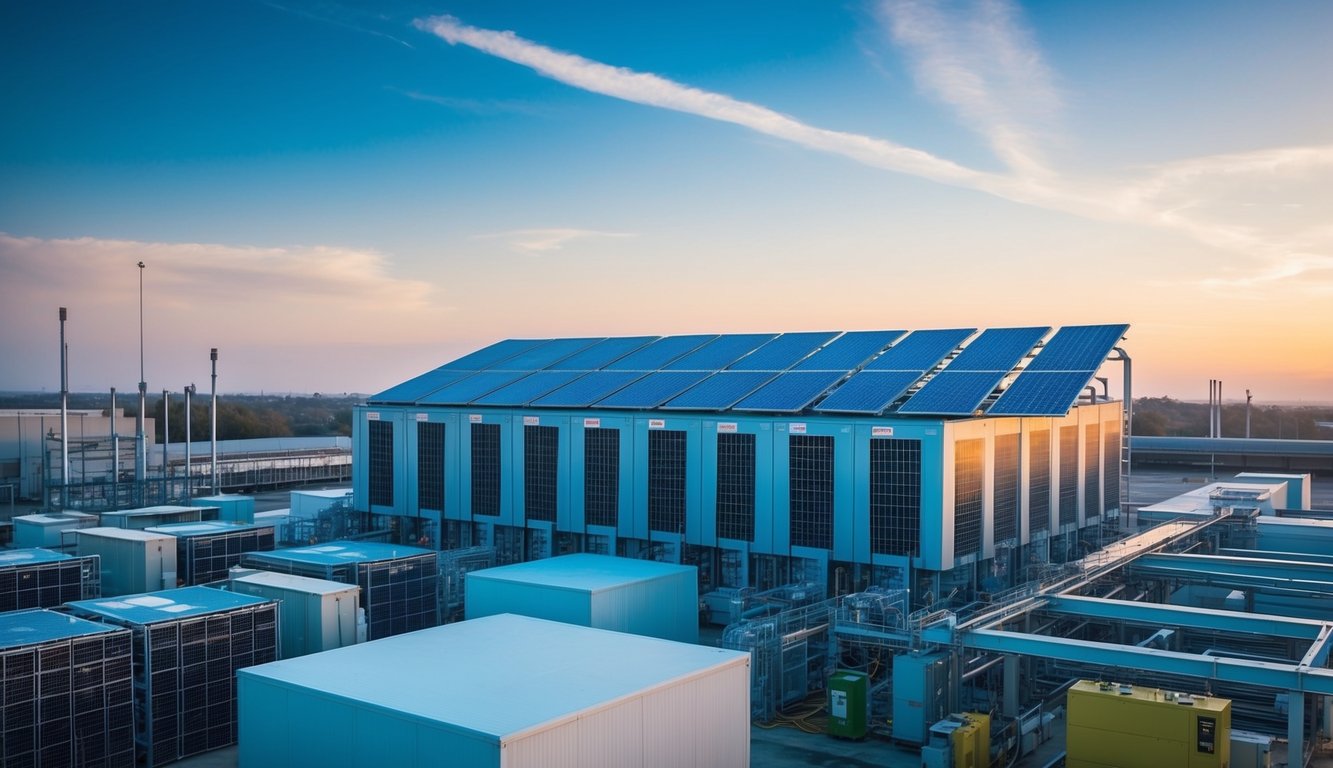Solar Panels for Data Centres, Telecoms & IT: Powering the Digital Future Sustainably
Solar panels offer data centres, telecoms, and IT infrastructure a sustainable energy solution to meet growing power demands. These facilities consume vast amounts of electricity, making renewable energy integration crucial for reducing operational costs and environmental impact.
Solar technology can supply a significant portion of a data centre’s energy needs while lowering reliance on the grid. By installing panels on rooftops, car parks, or adjacent land, companies maximise solar energy generation. Power storage solutions like batteries enable facilities to use excess energy during periods of low solar output or high demand.
For telecom and IT operations, solar power provides a reliable energy source that supports sustainability goals. It allows organisations to future-proof their infrastructure against rising energy costs and potential supply issues. As the digital landscape expands, solar panels offer a practical path to greener, more efficient operations.
Key Takeaways
- Solar panels can significantly reduce data centre energy costs and grid dependence
- Integrating solar power supports sustainability goals in IT and telecom sectors
- Proper system design is essential for maximising solar energy benefits in these facilities

What Are The Energy Challenges Facing Data Centres?
Data centres face significant energy-related obstacles as they strive to meet growing digital demands. These facilities grapple with high power consumption, environmental concerns, and escalating operational costs.
Current Energy Consumption Patterns
Data centres consume vast amounts of electricity to power servers, storage systems, and cooling infrastructure. The demand for energy is outpacing supply, creating a critical challenge for these facilities. Many data centres operate 24/7, requiring constant power to maintain uptime and performance.
Power usage effectiveness (PUE) remains a key metric for measuring energy efficiency. Despite improvements, numerous data centres still struggle to achieve optimal PUE ratios. The push for higher processing capabilities and increased data storage often leads to greater energy requirements.
Cooling systems account for a substantial portion of energy consumption. Traditional air conditioning methods can be inefficient, particularly in larger facilities. Some data centres are exploring innovative cooling techniques, such as liquid cooling or free air cooling, to reduce energy usage.
Environmental Impact Concerns
Data centres contribute significantly to carbon emissions due to their high energy consumption. This environmental footprint has become a pressing issue for organisations seeking to reduce their climate impact.
Carbon reduction targets are driving data centres to explore cleaner energy sources. Many facilities are incorporating renewable energy options, such as:
- Solar power
- Wind energy
- Hydroelectric power
Power purchase agreements (PPAs) with renewable energy providers offer a way for data centres to decrease reliance on fossil fuels. However, integrating these sustainable solutions can be complex and costly.
E-waste management presents another environmental challenge. The frequent upgrading of IT equipment leads to substantial electronic waste, requiring proper disposal and recycling practices.
Rising Operational Costs
Energy expenses form a significant portion of data centre operational costs. As electricity prices continue to rise, these facilities face mounting financial pressure.
Ageing infrastructure often leads to inefficiencies and higher energy consumption. Upgrading to more energy-efficient equipment can involve substantial upfront investments, creating a balancing act between short-term costs and long-term savings.
Peak demand charges pose a particular challenge. Data centres must manage their power usage to avoid costly spikes during high-demand periods. Some facilities are implementing load-shedding strategies, such as:
- Offloading non-critical systems during peak times
- Utilising energy storage solutions to smooth out demand
The need for backup power systems, like diesel generators, adds to operational expenses. Maintaining and testing these systems regularly contributes to overall costs.
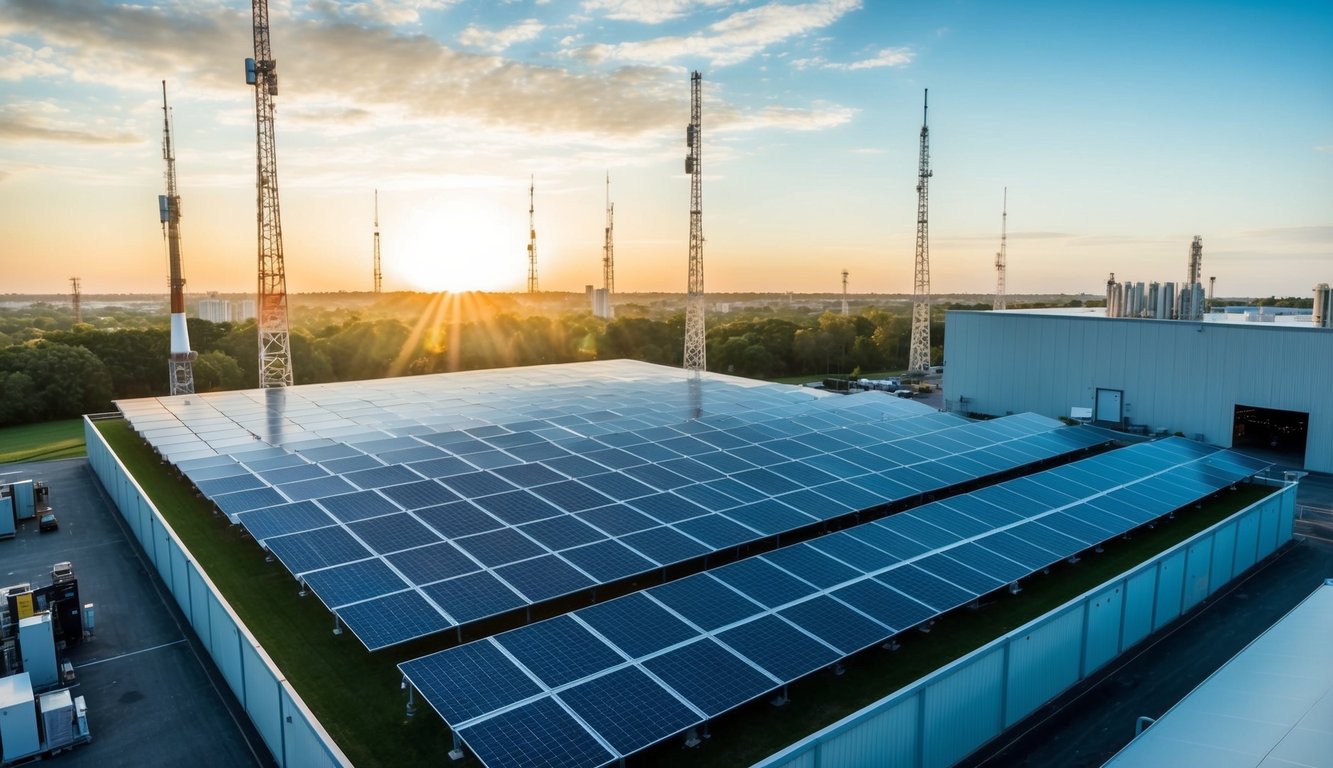
How Do Solar Panels Benefit Data Centre Operations?
Solar panels offer significant advantages for data centres, providing cost savings, environmental benefits, and improved energy security. These renewable energy systems transform operations by reducing expenses, enhancing sustainability, and increasing independence from traditional power sources.
Energy Cost Reduction
Solar panels help data centres slash electricity bills. By generating their own power, facilities can reduce reliance on grid electricity, often at a lower cost per kilowatt-hour. Many data centres implement Solar Power Purchase Agreements (PPAs), allowing them to buy solar energy at fixed, competitive rates.
A well-designed solar system can supply a substantial portion of a data centre’s energy needs. This reduces exposure to fluctuating energy prices and provides long-term cost stability. As solar technology improves, the cost-effectiveness of these systems continues to increase.
Data centres with large roof or ground spaces can maximise solar installations, potentially achieving significant energy autonomy during daylight hours.
Sustainability Improvements
Solar panels dramatically enhance data centre sustainability. By harnessing clean, renewable energy, facilities reduce their environmental impact and align with corporate social responsibility goals.
Many companies now prioritise green data centres to meet customer demands and regulatory requirements. Solar-powered facilities often earn certifications like LEED, boosting their reputation and appeal to environmentally conscious clients.
Solar energy’s scalability allows data centres to expand their renewable capacity as needed. This flexibility supports long-term sustainability strategies and helps future-proof operations against tightening environmental regulations.
Grid Independence Benefits
Solar panels increase data centre resilience by reducing reliance on the public power grid. This independence is crucial for maintaining uptime and service continuity.
During peak demand or grid outages, solar-equipped data centres can continue operations using their own power. This capability is especially valuable in areas with unreliable grid infrastructure or frequent power disruptions.
Microgrid systems incorporating solar panels, batteries, and smart controls further enhance energy security. These setups allow data centres to operate off-grid when necessary, ensuring uninterrupted service for critical applications.
Carbon Footprint Reduction
Solar panels play a vital role in shrinking data centre carbon footprints. By replacing fossil fuel-generated electricity with clean solar power, facilities significantly cut their greenhouse gas emissions.
Many data centres use solar as part of a broader strategy to achieve carbon neutrality or net-zero emissions. This approach often includes:
- Energy efficiency measures to reduce overall consumption
- Renewable energy credits to offset remaining emissions
- On-site generation to maximise clean energy use
Solar adoption helps data centres meet increasingly stringent carbon reduction targets set by governments and industry bodies. It also positions them favourably in a market where low-carbon services are becoming a competitive advantage.
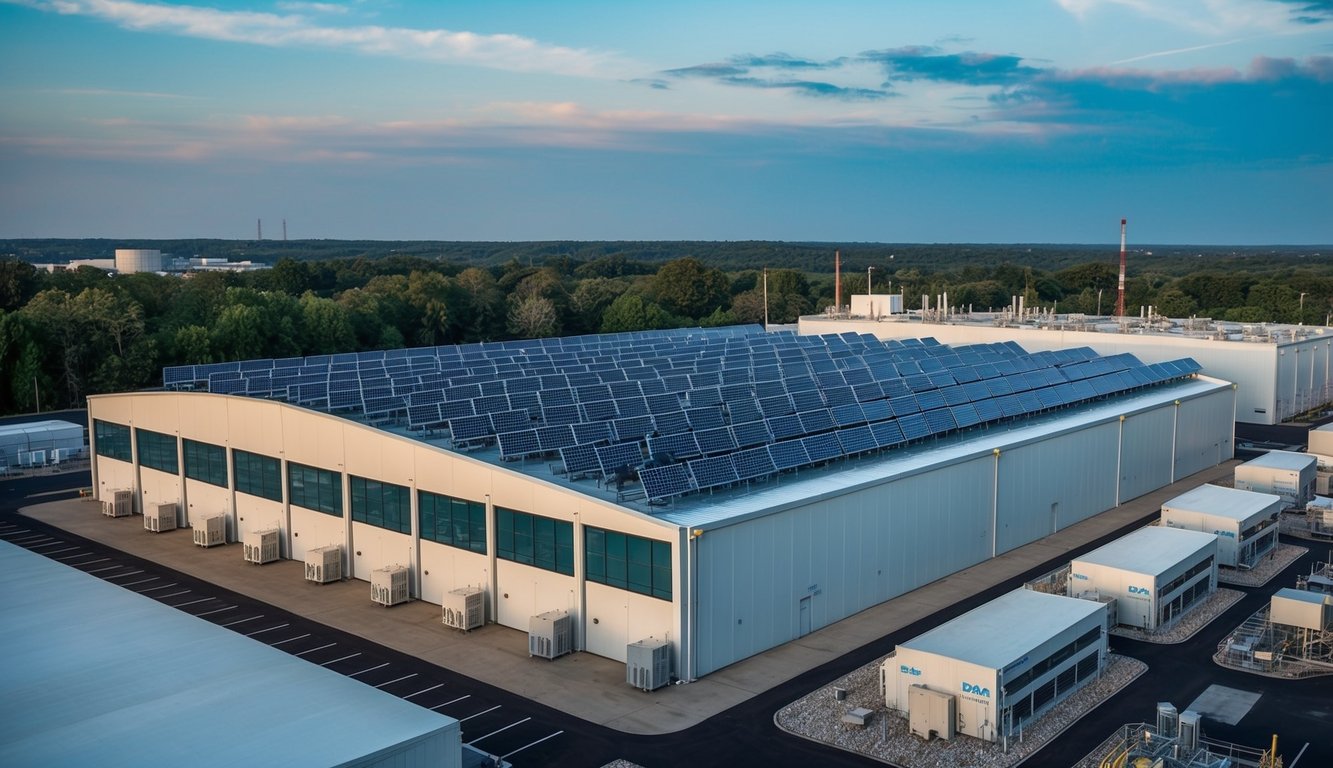
What Are The Technical Requirements For Data Centre Solar Systems?
Solar installations for data centres require careful planning and specific technical specifications. Power output, installation considerations, integration with existing systems, and energy storage solutions all play crucial roles in implementing effective solar power for IT infrastructure.
Power Output Specifications
Data centres require substantial energy to operate effectively. Solar systems must be sized appropriately to meet these demands. A typical 1MW solar array covers 4-5 acres and can power a small data centre. Larger facilities may need multiple arrays or supplemental power sources.
Solar panel efficiency is crucial. High-efficiency panels, typically monocrystalline, are preferred for their space-saving qualities and superior performance. These panels should have a power rating of at least 350W per panel.
Inverters must be robust enough to handle the DC to AC conversion for the entire system. They should be rated for the maximum potential output of the solar array.
Installation Requirements
Proper installation is vital for optimal solar system performance. Roof-mounted systems require:
- Structural integrity: Roofs must support the additional weight of panels and mounting equipment.
- Orientation: Panels should face south (in the Northern Hemisphere) for maximum sun exposure.
- Tilt angle: Optimal tilt varies by location but generally matches the site’s latitude.
Ground-mounted systems need:
- Ample space: Large, unobstructed areas for panel placement.
- Secure fencing: Protection against vandalism or accidental damage.
- Cabling infrastructure: To transmit power from the array to the data centre.
Both types require professional installation and adherence to local building codes and regulations.
Integration With Existing Infrastructure
Seamless integration with the data centre’s power systems is essential. This involves:
- Smart grid technology: To manage the flow of solar power and grid electricity.
- Power management systems: For balancing loads and optimising energy use.
- Monitoring software: To track solar production and overall energy consumption.
The solar system must be compatible with existing uninterruptible power supplies (UPS) and backup generators. This ensures continuous operation during cloudy periods or nighttime.
Energy-efficient cooling systems should be implemented alongside solar power to reduce overall energy demand.
Energy Storage Solutions
Battery storage systems are crucial for maximising solar power utilisation in data centres. They allow:
- Load shifting: Storing excess daytime solar energy for use during peak demand or nighttime hours.
- Grid independence: Reducing reliance on the public power grid.
- Emergency backup: Providing power during outages or low solar production periods.
Lithium-ion batteries are commonly used due to their high energy density and long lifespan. The storage capacity should be sized based on the data centre’s power requirements and the solar system’s output.
Smart battery management systems are essential for monitoring battery health, optimising charging cycles, and ensuring safe operation.
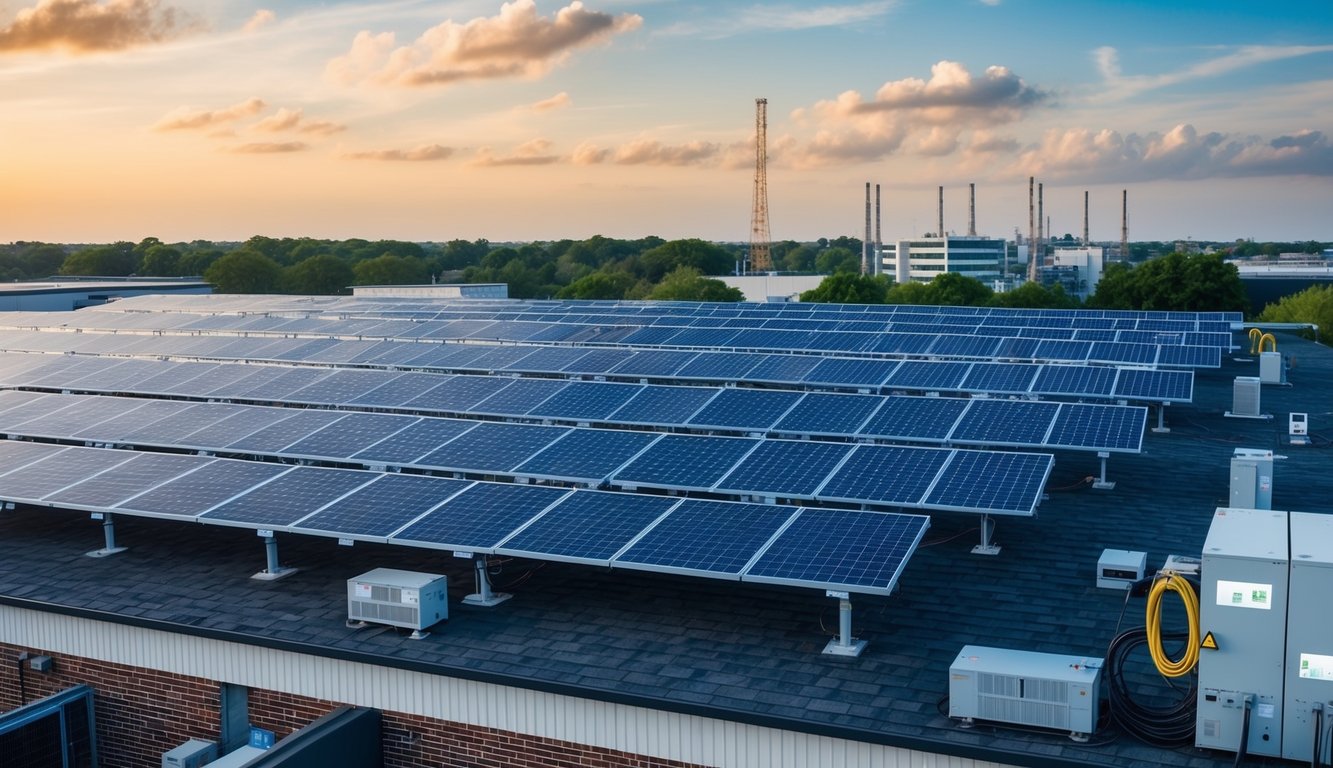
How Do Solar Panels Support Telecom Infrastructure?
Solar panels provide clean, renewable energy to power telecom infrastructure, enhancing reliability and reducing operational costs. They offer sustainable solutions for remote sites and base stations while improving network resilience.
Remote Site Applications
Solar panels excel in powering remote telecom sites. These installations often lack access to the electrical grid, making solar energy an ideal solution. Photovoltaic systems can be tailored to meet specific power requirements of each location.
Solar arrays, combined with battery storage, ensure continuous operation of remote equipment. This setup reduces the need for frequent diesel generator maintenance and refuelling trips. As a result, telecom companies save on fuel costs and minimise their carbon footprint.
In off-grid areas, solar-powered telecom towers expand network coverage to previously underserved regions. This technology bridges the digital divide, bringing communication services to rural and isolated communities.
Base Station Requirements
Base stations form the backbone of telecom networks, requiring reliable power sources. Solar panels can meet these demands effectively. A typical base station needs about 5 kW of power, which can be supplied by a 39 kW solar array covering roughly 260 square metres.
Key components of a solar-powered base station include:
- Photovoltaic panels
- Charge controllers
- Battery banks
- Inverters
These systems can be scaled to accommodate varying power needs across different types of base stations. For larger installations, ground-mounted solar arrays may be used, while smaller setups can utilise rooftop panels.
Network Reliability Improvements
Solar power enhances network reliability by providing a consistent energy source. Unlike grid electricity, which can be subject to outages, solar systems offer uninterrupted power supply when properly designed.
Hybrid systems, combining solar with grid power or diesel generators, further improve reliability. These setups use solar as the primary source, with alternative power kicking in during periods of low sunlight or high demand.
Benefits of solar for network reliability:
- Reduced downtime: Fewer power-related outages
- Consistent service: Stable energy supply for equipment
- Grid independence: Less vulnerability to utility failures
Backup Power Systems
Solar panels play a crucial role in backup power systems for telecom infrastructure. When integrated with battery storage, they provide a dependable source of emergency power during grid failures or natural disasters.
Modern lithium-ion batteries paired with solar arrays can store excess energy generated during sunny periods. This stored power can then be used during nighttime or cloudy conditions, ensuring continuous operation of critical telecom equipment.
Telecom companies can design backup systems to support various durations of operation, from a few hours to several days. This flexibility allows for tailored solutions based on local conditions and network requirements.
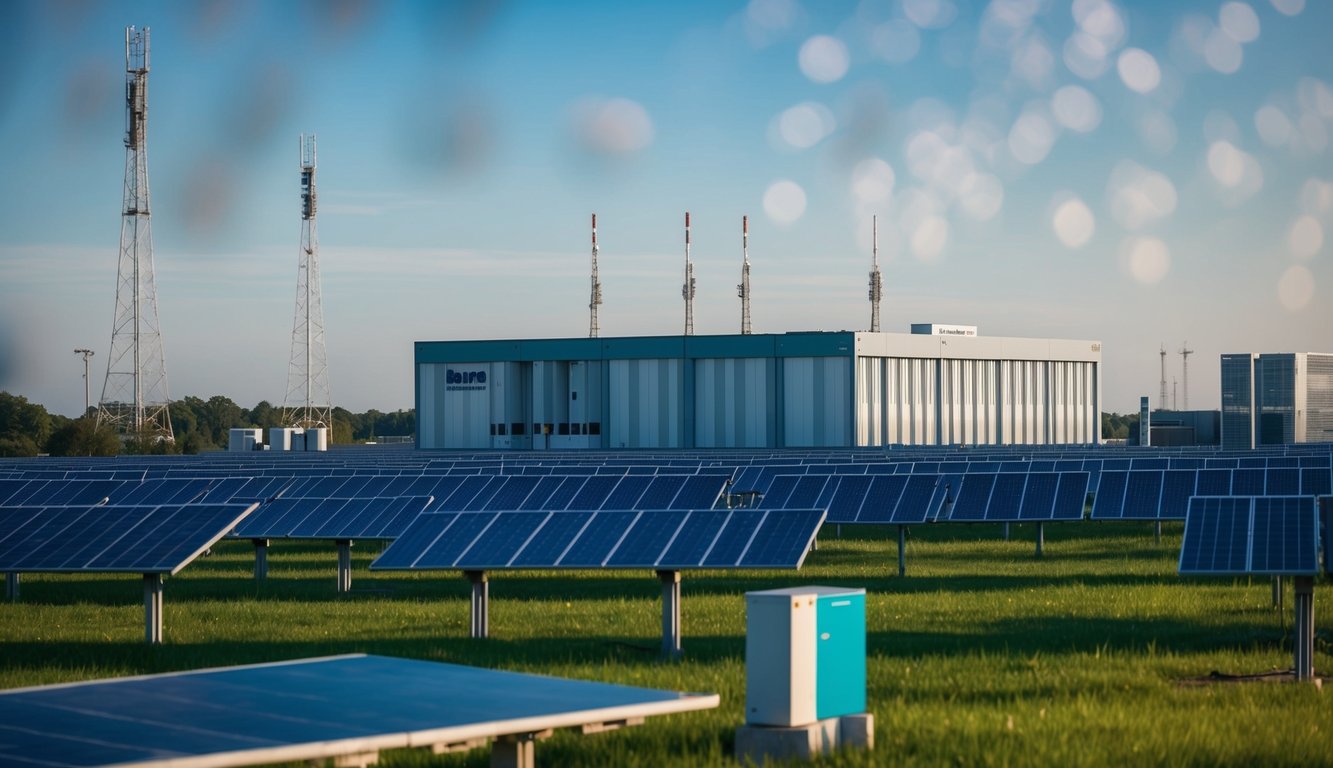
What Are The Financial Considerations?
Solar panels for data centres involve significant financial factors that require careful evaluation. Assessing costs, returns, incentives, and ongoing expenses is crucial for making informed decisions.
Initial Investment Costs
Implementing solar panels for data centres requires substantial upfront capital. The primary expenses include:
Solar panels: High-quality photovoltaic modules form the core of the system.
Inverters: Convert DC power from panels to AC for use in the facility.
Mounting structures: Support and secure panels on rooftops or ground-mounted arrays.
Wiring and electrical components: Connect the system to the data centre’s power infrastructure.
Installation labour: Professional teams to set up and integrate the solar system.
Costs vary based on system size, panel efficiency, and site-specific factors. For large data centres, economies of scale may reduce per-watt prices. It’s wise to obtain quotes from multiple suppliers to compare options.
Return On Investment Analysis
Calculating ROI helps determine the financial viability of solar projects for data centres. Key factors to consider:
Energy savings: Reduced grid electricity consumption leads to lower utility bills.
Power purchase agreements (PPAs): Long-term contracts can provide stable, predictable energy costs.
Increased property value: Solar installations may enhance the data centre’s market worth.
Carbon reduction benefits: Meeting sustainability goals can improve corporate image and attract clients.
A typical ROI timeline for data centre solar projects ranges from 5-10 years, depending on local energy prices and system efficiency. Conducting a thorough cost-benefit analysis using projected energy production and consumption data is essential.
Available Government Incentives
Many governments offer financial incentives to encourage solar adoption in commercial settings:
Tax credits: Reduce tax liability based on a percentage of solar system costs.
Grants: Direct financial assistance for renewable energy projects.
Feed-in tariffs: Payments for excess energy fed back into the grid.
Accelerated depreciation: Allows faster write-offs of solar investments.
These incentives can significantly improve project economics. However, availability and terms vary by location and may change over time. Consulting with local energy agencies or solar specialists can help identify current opportunities.
Maintenance Expenses
Ongoing maintenance costs for data centre solar systems are generally low but should be factored into financial planning:
- Regular cleaning: Removes dust and debris to maintain optimal performance.
- Inverter replacement: May be necessary every 10-15 years.
- Panel degradation: Output typically decreases by 0.5-1% annually.
- Monitoring systems: Help detect and address issues promptly.
Annual maintenance costs usually range from 0.5-1% of the initial system cost. Establishing a maintenance reserve fund ensures resources are available for future upkeep and repairs.
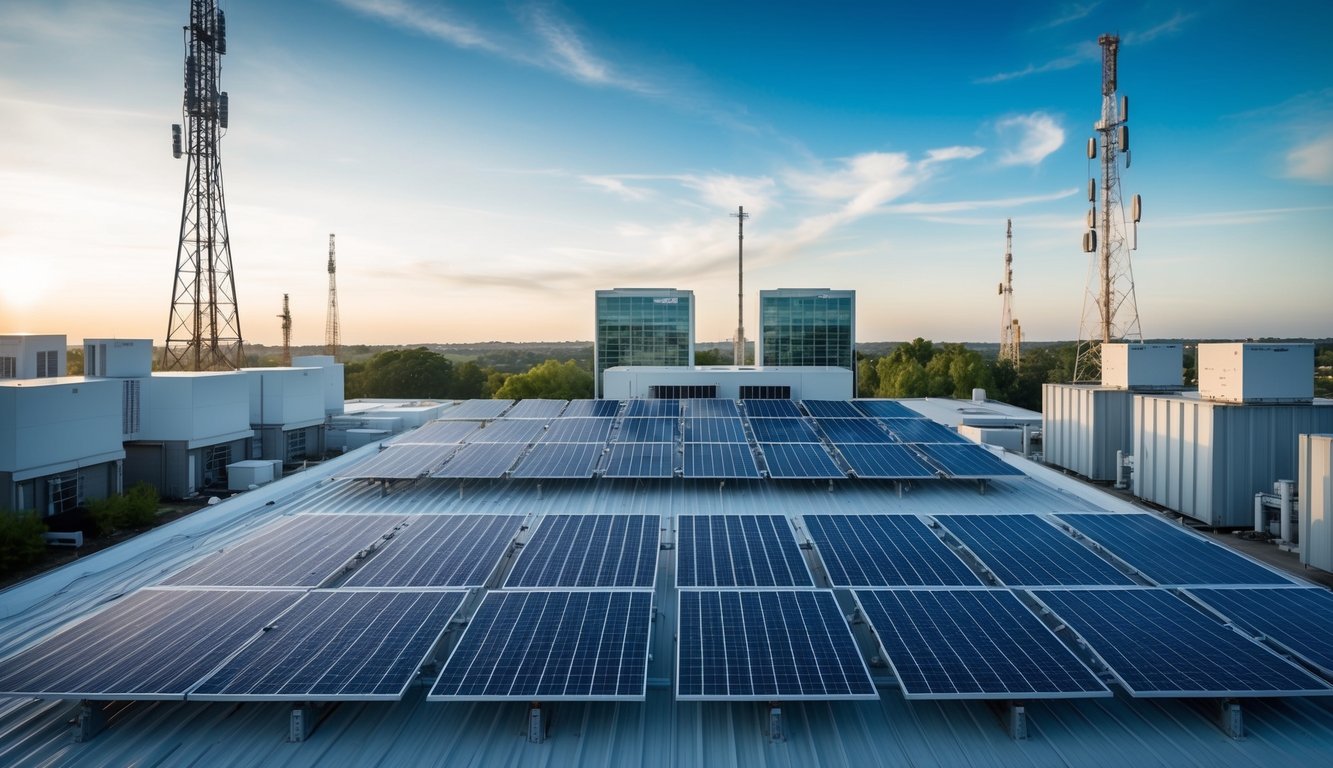
How Does Solar Technology Impact IT Sustainability?
Solar technology profoundly influences IT sustainability by reducing carbon emissions, lowering operational costs, and enhancing energy independence for data centres and IT infrastructure.
Green Computing Initiatives
Solar panels enable data centres to implement green computing initiatives effectively. By harnessing renewable energy, these facilities significantly reduce their carbon footprint. Solar power integration allows IT operations to run on clean energy, minimising reliance on fossil fuels.
Many data centres now incorporate rooftop solar installations or partner with nearby solar farms. This shift towards solar energy aligns with corporate sustainability goals and helps meet growing customer demands for environmentally responsible IT services.
Solar-powered IT infrastructure also supports the development of eco-friendly cloud computing solutions. As more businesses migrate to the cloud, solar-enabled data centres ensure these digital transformations occur sustainably.
Energy Efficiency Metrics
Solar technology improves key energy efficiency metrics for IT facilities. The Power Usage Effectiveness (PUE) ratio, which measures total facility energy compared to IT equipment energy, can be significantly enhanced with solar integration.
Solar panels help reduce grid electricity consumption, leading to better PUE scores. This improvement reflects more efficient energy use and lower operational costs.
Another crucial metric, Carbon Usage Effectiveness (CUE), directly benefits from solar adoption. CUE measures the total CO2 emissions caused by a data centre’s energy consumption. Solar power dramatically reduces these emissions, resulting in improved CUE values.
IT managers can leverage these enhanced metrics to demonstrate tangible progress in sustainability efforts to stakeholders and clients.
Environmental Compliance
Solar technology aids IT facilities in meeting stringent environmental regulations. Many countries now mandate renewable energy adoption and carbon emission reductions for large-scale IT operations.
By integrating solar power, data centres can more easily comply with these regulations without compromising performance. Solar adoption helps IT companies avoid potential fines and penalties associated with non-compliance.
Moreover, solar-powered IT infrastructure often qualifies for government incentives and tax breaks. These financial benefits make the transition to sustainable technology more economically viable for businesses.
Solar adoption also supports IT companies in achieving certifications like LEED (Leadership in Energy and Environmental Design). These credentials enhance corporate reputation and appeal to environmentally conscious clients.
Future Technology Trends
Emerging solar technologies promise even greater sustainability benefits for IT infrastructure. Bifacial solar panels, which capture sunlight from both sides, offer increased energy generation efficiency for data centres with limited roof space.
Advancements in energy storage solutions, such as high-capacity batteries, allow IT facilities to maximise solar power utilisation. These systems enable operations to run on stored solar energy during cloudy days or at night.
The integration of artificial intelligence with solar power systems is set to optimise energy management in IT infrastructure. AI algorithms can predict energy needs and adjust solar capture and storage accordingly, further enhancing efficiency.
As solar cell efficiency continues to improve, IT facilities will be able to generate more power from smaller installations. This trend will make solar adoption increasingly feasible for urban data centres with space constraints.
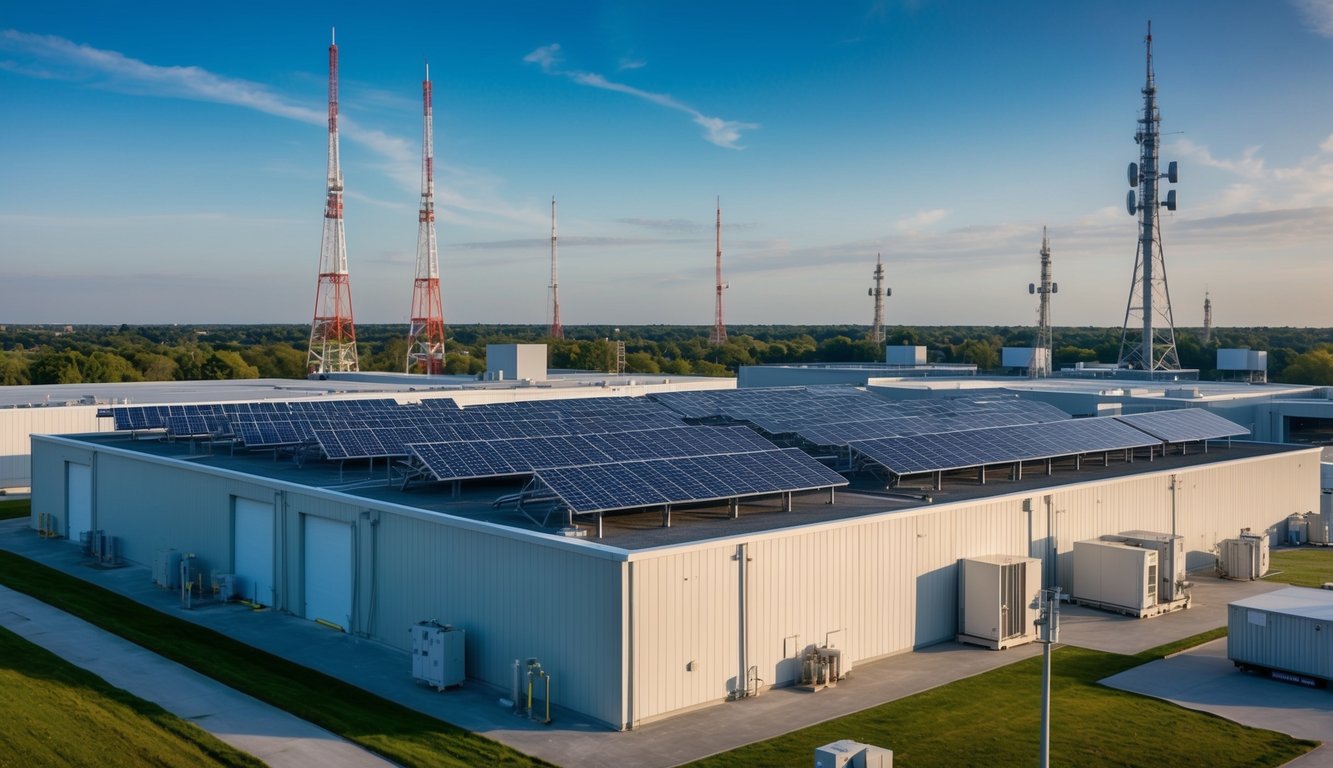
Conclusion
Solar panels offer a promising solution for data centres, telecoms, and IT infrastructure to reduce energy costs and environmental impact. By harnessing the sun’s power, these facilities can significantly decrease their reliance on traditional electricity sources. The integration of solar technology provides numerous benefits:
• Cost savings: Lower long-term energy expenses
• Sustainability: Reduced carbon footprint and improved environmental stewardship
• Energy independence: Less vulnerability to grid fluctuations and outages
• Positive public image: Enhanced reputation as an eco-conscious organisation
While initial installation costs may be substantial, the long-term advantages often outweigh this investment. Power Purchase Agreements (PPAs) present an alternative financing option, allowing facilities to benefit from solar energy without upfront expenses.
It’s crucial to consider site-specific factors when implementing solar solutions:
- Available roof or land space
- Local climate and sunlight patterns
- Energy storage capabilities
- Grid integration requirements
As technology advances, solar panels become increasingly efficient and cost-effective. This trend suggests a bright future for solar-powered data centres, telecoms, and IT infrastructure. By embracing solar energy, you position your facility at the forefront of sustainable technology practices, contributing to a cleaner, greener future for the industry.
Frequently Asked Questions
Solar panels offer numerous benefits for data centres, telecoms, and IT infrastructure. These solutions address energy efficiency, cost reduction, and sustainability concerns in the industry.
How are solar panels integrated into data centre operations?
Solar panels are installed on rooftops, parking areas, or adjacent land to maximise energy generation for data centres. The integration process involves connecting the panels to the facility’s power system through inverters and distribution equipment. Energy storage solutions, such as batteries, are often included to store excess power for use during low-generation periods or peak demand times.
What advancements have been made in solar technology for telecommunications?
Recent advancements in solar technology for telecommunications include more efficient photovoltaic cells, improved energy storage systems, and smart grid integration. Thin-film solar panels, which are lighter and more flexible, have become increasingly popular for remote telecom towers. Additionally, solar-powered small cells and micro-data centres are being developed to support 5G networks in urban areas.
Can Internet of Things (IoT) devices be powered effectively by solar energy?
Yes, IoT devices can be effectively powered by solar energy. Many IoT sensors and devices have low power requirements, making them well-suited for solar power solutions. Solar-powered IoT devices often incorporate small photovoltaic cells and energy-efficient batteries to maintain operation during low-light conditions. This approach enables deployment in remote locations and reduces maintenance needs.
What are the cost implications of adopting solar energy solutions in IT infrastructure?
Adopting solar energy solutions in IT infrastructure involves significant upfront costs for equipment and installation. However, these systems typically result in long-term savings on electricity bills. The payback period varies depending on factors such as local energy prices, solar panel efficiency, and available incentives. Many organisations find that solar investments yield positive returns within 5-10 years.
What are the efficiency considerations when implementing solar power in data centres?
Efficiency considerations for solar power in data centres include panel orientation, shading, and local climate conditions. Proper system sizing is crucial to meet energy demands without overproducing. Advanced monitoring systems help optimise performance and identify maintenance needs. Additionally, integrating solar power with other energy-efficient technologies, such as liquid cooling and AI-driven workload management, can further enhance overall data centre efficiency.
What sustainability benefits do solar panels offer for the IT and telecoms industry?
Solar panels provide significant sustainability benefits for the IT and telecoms industry. They reduce reliance on fossil fuels, lowering carbon emissions and supporting corporate sustainability goals. Solar power helps companies meet regulatory requirements and improves their environmental reputation. Additionally, solar installations can contribute to local biodiversity by creating habitats for wildlife when implemented thoughtfully on unused land.

